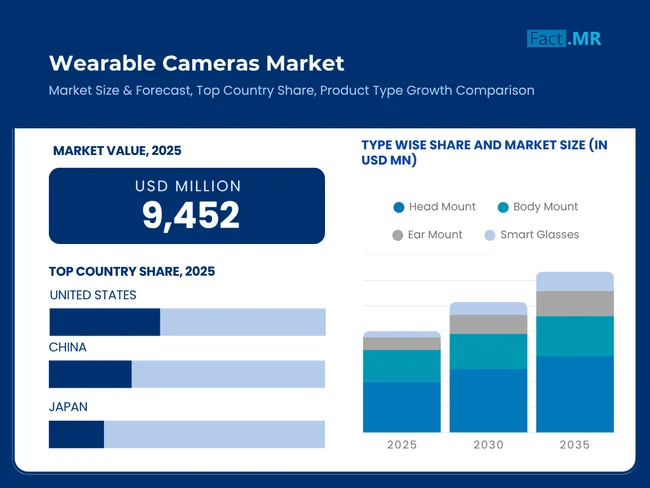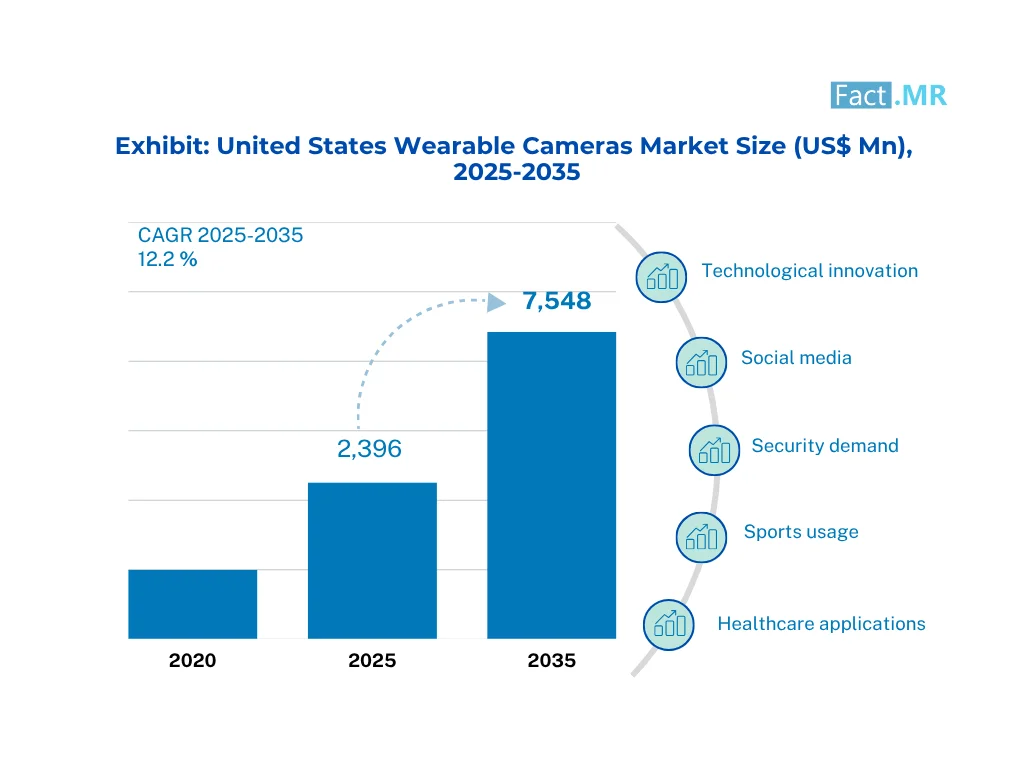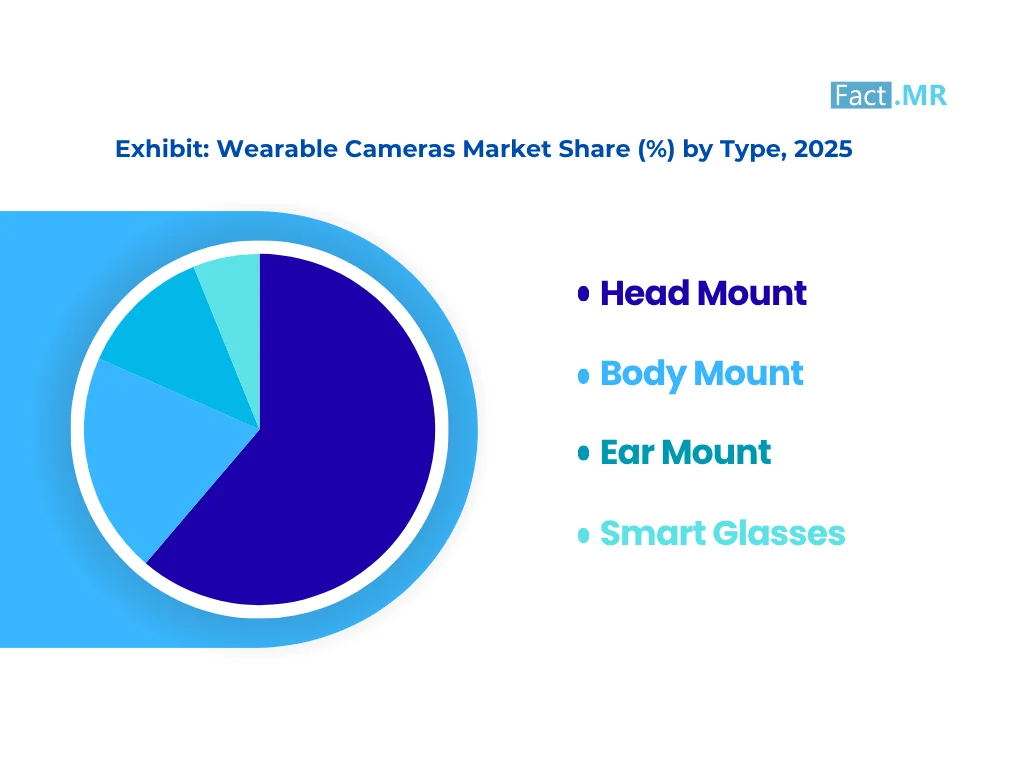Wearable Cameras Market
Wearable Cameras Market Analysis, By Type, By Product (Cameras and Accessories), By Application, and Region - Market Insights 2025 to 2035
Analysis of Wearable Cameras Market Covering 30+ Countries Including Analysis of US, Canada, UK, Germany, France, Nordics, GCC countries, Japan, Korea and many more
Wearable Cameras Market Outlook (2025 to 2035)
The global wearable cameras market is expected to reach USD 35,973 million by 2035, up from USD 8,213 million in 2024. During the forecast period (2025-2035), the industry is projected to register a CAGR of 14.3%, driven by the increasing prevalence of adventure tourism and growing demand for hands-free video recording.

What are the drivers of wearable camera market?
Market players in wearable cameras anticipate increased demand from individuals who want to take photos and record videos hands-free, particularly in adventure tourism, sports, and vlogging. Lightweight and compact solutions have gained popularity in action sports, allowing users to record first-person experiences in the midst of action and introducing their devices to lifestyle vloggers.
Improved technology, including 4K recording, waterproofing, shockproofing, and IoT and mobile app integration, is enhancing product attractiveness. Increased demand is also bolstered by the proliferation of smart surveillance in the police and military sectors, where wearable cameras facilitate on-demand data gathering and transparency.
Wearable cameras have become a common content creation device due to the exploding use of social media and the generation of user-generated content. The prices of the devices are also dropping, further reinforcing demand, as mounting accessories are becoming more flexible. As athletic monitoring and 360-degree content production transition to mainstream uses, wearable cameras are being transformed into a necessary piece of lifestyle technology.
What are the regional trends of wearable cameras market?
The North American region leads in the use of wearable cameras in the market, driven by high consumption among sports enthusiasts, vloggers, and security authorities. The U.S. is experiencing robust adoption at both the consumer and enterprise levels, due to tech-savvy consumers and positive investments in surveillance infrastructure.
Europe is not far behind, with increasing installations during law enforcement activities and a growing enthusiasm for adventure sports among people in Germany, the UK, and France. Regional growth is also facilitated by the regulatory push to police accountability and body-worn camera requirements.
The fastest growth is most likely to occur in the Asia Pacific region, as China, Japan, and India are expected to adopt wearable tech for both personal and professional purposes. The increasing disposable income, the growth of the digital environment, and a large population of the younger generation present a favorable environment for the expansion of the wearable cameras market.
Latin America, the Middle East, and Africa are emerging, primarily in high-income cities. The increasing use of smartphones and the growing popularity of social media are expected to drive demand for wearable cameras in these areas during the review period.
What are the challenges and restraining factors of wearable cameras market?
Costly equipment is still one of the leading hindrances to mass market penetration, especially in value-conscious locations. Even in the era of technologies, wearable cameras supported by consumers do not have a mass adoption due to the perception that these devices are borderline luxury, non-essential items.
There are also functional limits related to battery power and storage capacity, particularly for users streaming high-definition video during prolonged outdoor activities. Additionally, concerns about privacy, such as the permitted use of unauthorized surveillance or recording in both personal and business contexts, are issues that raise governing concerns and consumer reluctance.
Smartphones also create intense competition in the market due to their high-resolution cameras and video capabilities, which often render wearable cameras unnecessary for most users. Compatibility with third-party apps, cloud services, or body mounts is also part of the technical integration question that may impact a smooth user experience.
Country-Wise Outlook
In the United States, adventure and action sports fuel robust growth

The use of wearable cameras in the United States is primarily driven by the country's thriving culture of action sports, as well as the activities of military and law enforcement agencies, combined with the widespread consumer acceptance of smart wearable devices. Regarding their popularity with a large base of outdoor enthusiasts and vloggers, the GoPro device (users buy and sell used GoPros worldwide), body-worn cameras, especially in law enforcement, have seen a rise in popularity after federal grants and transparency requirements.
Real-time analytics, the use of automatic incident tagging, and the integration of AI through facial recognition are increasing adoption rates. Institutional use has been intensified by policies such as the Department of Justice's Body-Worn Camera Program. Stabilization, 4K streaming, and cloud syncing are also becoming standard features in consumer models. There is also massive 5G infrastructure, as well as integrations of wearable tech with platforms in the U.S.
China’s smart surveillance ecosystem drives wearable camera demand
China is a significant production center and a rapid user of wearable cameras, particularly in security, industrial monitoring, and smart city initiatives. Urban safety initiatives, an increased surveillance system for crime, a vlogging ecosystem, and the effect of increased demand.
Chinese companies are utilizing artificial intelligence-enabled image recognition, edge computing, and GPS-equipped body cameras for police and street workers. As part of the Safe City initiative, there is an increasing use of government procurement for body-worn cameras in traffic enforcement and other safety-related issues. Compact streaming gadgets and camera glasses are also covering new ground in the educational and tourism sectors, alongside the current markets.
Japan’s high-tech society and aging population bolster wearable camera innovation
Japan is distinguished in the wearable cameras industry by combining two trends: miniaturization and care of the elderly, with a culture of technology. The increasing demand for caregiving, disaster response, and security in public transport systems can be attributed to the aging population in the country and stringent checkup procedures in cities.
Fall detection and face recognition, as well as wearable location cameras fitted with AI, are becoming a part of nursing homes and home-based care providers. Innovation among companies is also taking the form of lightweight compact cameras that can be used by commuters and travelling individuals with in-built real-time translation and intelligent navigation capabilities. Society 5.0 has driven government efforts in the development of connected health and security infrastructure, which will enable wearable technology in its next generation to thrive.
Category-Wise Analysis
Head-mounted wearable cameras gain traction in dynamic, hands-free environments

The popularity of wearable cameras worn on the head is gaining traction in industries where hands-free operation is not necessary and where point-of-view recording is preferable. Their healthy and secure stance allows individuals, especially sportspeople, those in high-risk areas, and video makers to shoot video on the go without turning away. Whether it is military exercise, extreme sports or factory inspection, this kind may provide an incomparable overview and maneuver.
Image stabilization, high-definition recording, and the integration with an AR/VR interface are some additional technological features that enhance the significance of head-mounted devices. They are also enhancing the efficiency of workflows across various industries, including the public safety sector, adventure tourism, and field services, as they are increasingly utilized in live streaming, training modules, and tactical communication.
Camera-focused wearables lead innovation in smart recording devices
Cameras are still the hardware that will run the wearable ecosystem. The balance between miniaturization, durability, and smart capabilities, such as AI-powered framing, low-light capabilities, and cloud integration, is achieved in these products. The wearable camera market is no longer analyzed solely as the capture side of the market; the wearable device is also becoming an expandable market that offers real-time data processing, tagging, and secure transfer, broadening its market reach into both consumer and professional markets.
Advancement in lens technology, edge computing, 5G connectivity are making these cameras useful in a wider array of uses than just cinematic action sports footage to situational awareness during a security operation. As the use cases of compact, high-performance capture devices increase, wearable cameras are also coming equipped with their own embedded biometric sensors and voice-control systems, following the trend of smart ecosystems.
Sports & fitness applications fuel the mainstream adoption of wearable cameras
The most obvious frontier of wearable camera use is the sports and fitness category, whose dynamic action, exercise regimes, and outdoor activities have developed a thriving consumer base. Hobbyists and professional photographers use these devices alike to study form, share activities via social media, or relive situations with a first-person view.
This field can also utilize wrist- or chest-worn cameras designed to withstand rough conditions. They are waterproof, shockproof, and have long battery life. As more people become interested in adventure sports, gamified workouts, and new forms of exercise, the digital fitness platform market continues to rise, making it a great breeding ground for applications and innovation.
Competitive Analysis
The wearable cameras market is highly characterized by product differentiation and innovation, resulting in a fragmented yet dynamic market competition. There are several areas where companies compete, including form factor (glasses, body mounts, and helmet cams), battery life, video resolution, and wireless connectivity.
Demand has driven niche applications to grow, including those in law enforcement, adventure tourism, content creation and enterprise fieldwork, creating a demand in both rugged and lightweight versions of the models.
Cycles of innovation are shorter now, and producers heavily invest in AI-based options, like auto-editing, object tracking, and real-time streaming. Additionally, joint ventures are becoming a major competitive strategy for easily integrating media management and analytics.
Technically, North America and Europe continue to be technological hubs, whereas the Asia Pacific region is catching up in terms of scale of manufacture and low-cost services. To support outdoor and tactical applications, market players are increasingly turning to the idea of durability, water resistance, and multi-environment applicability.
The risks associated with entering continue to be moderate due to the necessity of a powerful hardware-software combination; however, improvements in miniaturized sensors, as well as open-source software, have reduced the initial funding required for R&D processes. The strategic differentiation is shifting toward the compatibility of the ecosystem and user experience, rather than raw hardware specifications.
Key players in the wearable camera industry include Sony Corporation, Garmin Ltd., GoPro Inc., Narrative AB, Pinnacle Response Ltd., Axon Enterprise Inc., Vievu LLC, Drift Innovation Ltd., Xiaomi, and other notable companies.
Recent Development:
- In June 2025, Snap Inc. announced the launch of its new lightweight, immersive Specs in 2026. These AR glasses are designed to enhance the physical world with digital experiences, integrating a powerful wearable computer into a sleek design. The Specs aim to revolutionize augmented reality by providing users with seamless digital overlays in their everyday environment.
- In April 2025, Meta expanded the rollout of Meta AI on its Ray-Ban Meta smart glasses to additional European countries. This update enables users to interact with their surroundings using voice commands, receiving smart and helpful answers about what they see, thereby enhancing the hands-free experience.
Fact.MR has provided detailed information about the price points of key manufacturers in the wearable camera market, positioned across regions, including sales growth, production capacity, and speculative technological expansion, in the recently published report.
Methodology and Industry Tracking Approach
The wearable cameras market study was carried out by Fact.MR in 2025 contains 13200 participants representing 38 countries, with at least 375 participants per market. About two-thirds of the respondents were end-users or vendors (of adventure gear to public security providers). At the same time, the other one-third consisted of industry planners, procurement heads, and smart infrastructure consultants.
The source of insights would be obtained over 12 months, beginning June 2024 and ending May 2025, on the basis of market demand changes, investment priorities and risks involved in operations and unmet business requirements throughout the value chain.
The results were supported by more than 320 sources, ranging from academic literature to technology filings, official regulations, and financial records. In the process of accuracy, a data modeling tool, specifically cluster mapping and regression forecast modeling, was utilized.
Since 2018, Fact.MR has been observing the shifts in user adoption, service innovation, and global market dynamics, which demonstrate that this report serves as a primary source to guide readers through this segment of the wearable camera market.
Segmentation of Wearable cameras market
-
By Type :
- Head Mount
- Body Mount
- Ear Mount
- Smart Glasses
-
By Product :
- Cameras
- Accessories
-
By Application :
- Sports & Fitness
- Military & Defense
- Manufacturing
- Healthcare
- Others
-
By Region :
- North America
- Latin America
- Western Europe
- Eastern Europe
- East Asia
- South Asia & Pacific
- Middle East & Africa
Table of Content
- Executive Summary
- Industry Introduction, including Taxonomy and Market Definition
- Trends and Success Factors, including Macro-economic Factors, Market Dynamics, and Recent Industry Developments
- Global Market Demand Analysis 2020 to 2024 and Forecast 2025 to 2035, including Historical Analysis and Future Projections
- Global Market Analysis 2020 to 2024 and Forecast 2025 to 2035
- Type
- Product
- Application
- Global Market Analysis 2020 to 2024 and Forecast 2025 to 2035, By Type
- Head Mount
- Body Mount
- Ear Mount
- Smart Glasses
- Global Market Analysis 2020 to 2024 and Forecast 2025 to 2035, By Product
- Cameras
- Accessories
- Global Market Analysis 2020 to 2024 and Forecast 2025 to 2035, By Application
- Sports & Fitness
- Military & Defense
- Manufacturing
- Healthcare
- Others
- Global Market Analysis 2020 to 2024 and Forecast 2025 to 2035, By Region
- North America
- Latin America
- Western Europe
- South Asia & Pacific
- East Asia
- Eastern Europe
- Middle East & Africa
- North America Sales Analysis 2020 to 2024 and Forecast 2025 to 2035, by Key Segments and Countries
- Latin America Sales Analysis 2020 to 2024 and Forecast 2025 to 2035, by Key Segments and Countries
- Western Europe Sales Analysis 2020 to 2024 and Forecast 2025 to 2035, by Key Segments and Countries
- South Asia & Pacific Sales Analysis 2020 to 2024 and Forecast 2025 to 2035, by Key Segments and Countries
- East Asia Sales Analysis 2020 to 2024 and Forecast 2025 to 2035, by Key Segments and Countries
- Eastern Europe Sales Analysis 2020 to 2024 and Forecast 2025 to 2035, by Key Segments and Countries
- Middle East & Africa Sales Analysis 2020 to 2024 and Forecast 2025 to 2035, by Key Segments and Countries
- Sales Forecast to 2035 by Type, Product, and Application for 30 Countries
- Competitive Assessment, Company Share Analysis by Key Players, and Competition Dashboard
- Company Profile
- Sony Corporation
- Garmin Ltd.
- GoPro Inc.
- Narrative AB
- Pinnacle Response Ltd.
- Axon Enterprise Inc.
- Vievu LLC
- Drift Innovation Ltd.
- Xiaomi
- FAQs -
What was the global wearable cameras market size reported by Fact.MR for 2025?
The Global Wearable cameras market was valued at USD 9,452 Million in 2025.
Who are the major players operating in the wearable cameras market?
Prominent players in the market Sony Corporation, Garmin Ltd., GoPro Inc., Narrative AB, Pinnacle Response Ltd., Axon Enterprise Inc., Vievu LLC, Drift Innovation Ltd., and Xiaomi.
What is the Estimated Valuation of the wearable cameras market in 2035?
The market is expected to reach a valuation of USD 35,973 Million in 2035.
What Value CAGR did the wearable cameras market exhibit over the Last Five Years?
The historic growth rate of the wearable cameras market was 13.1% from 2020 to 2024.